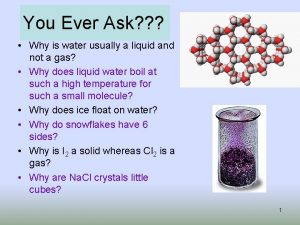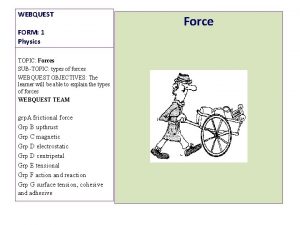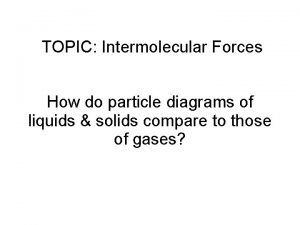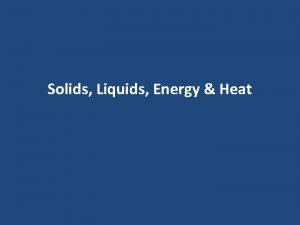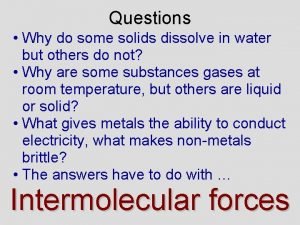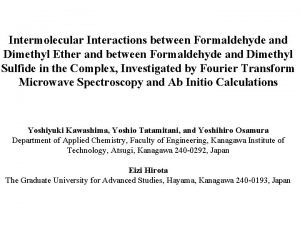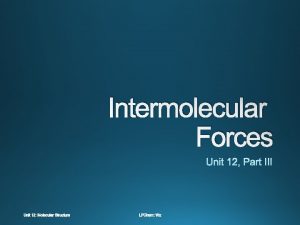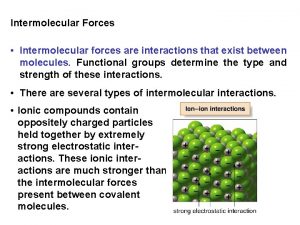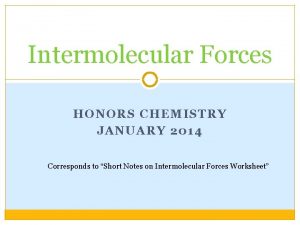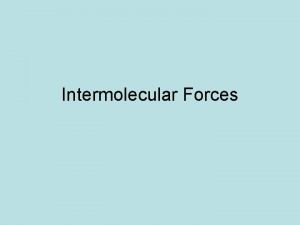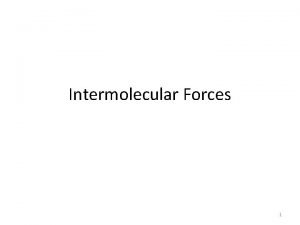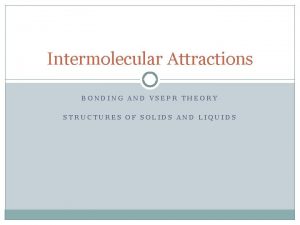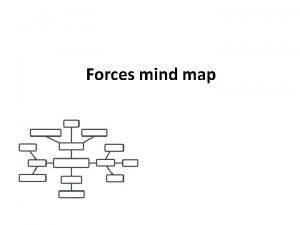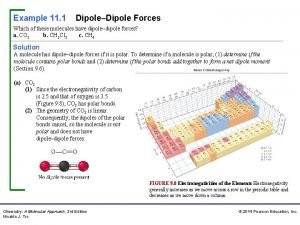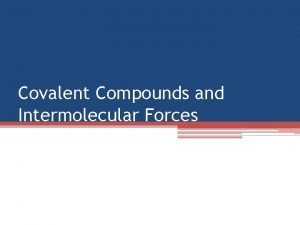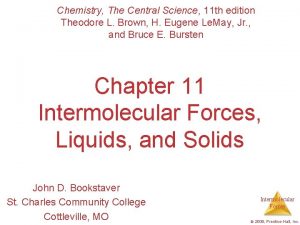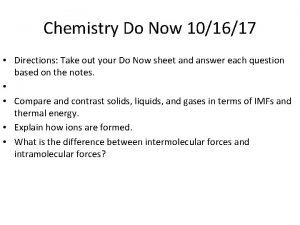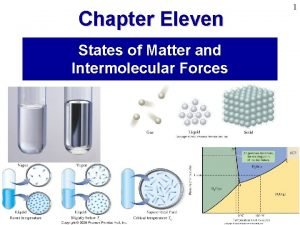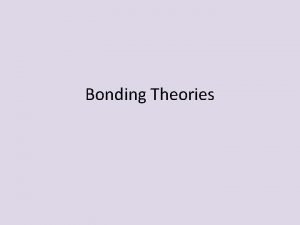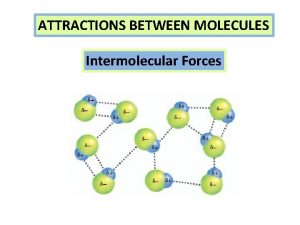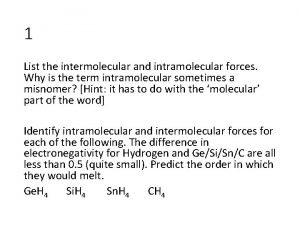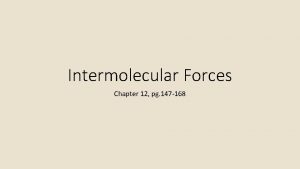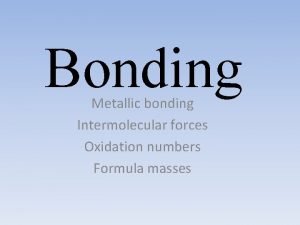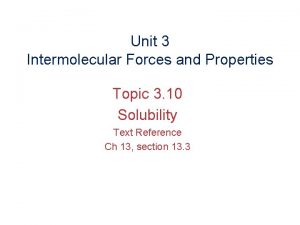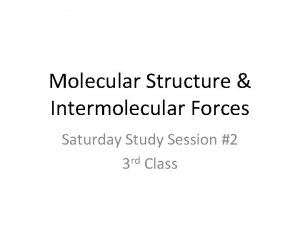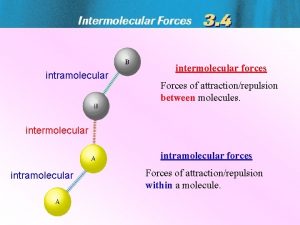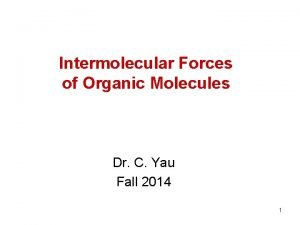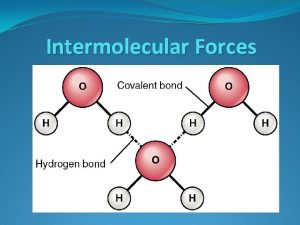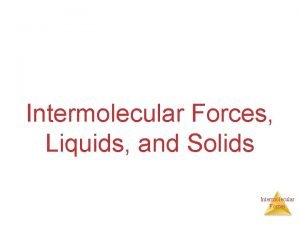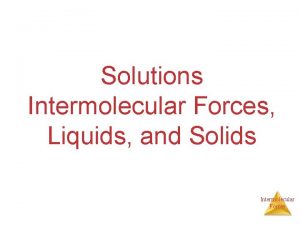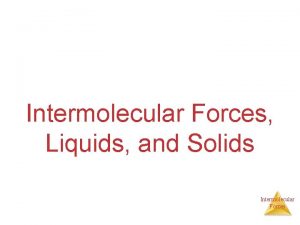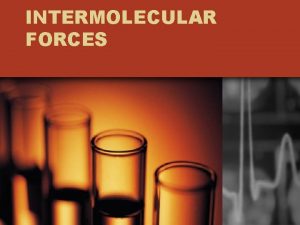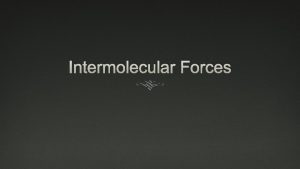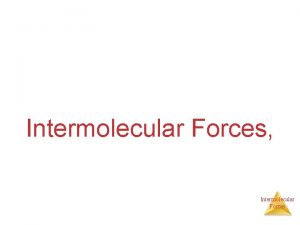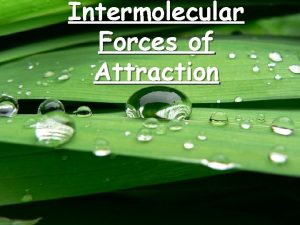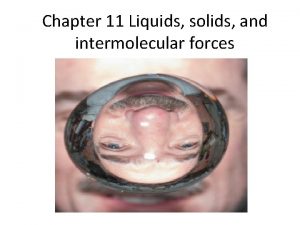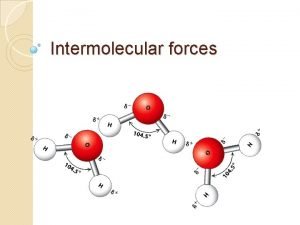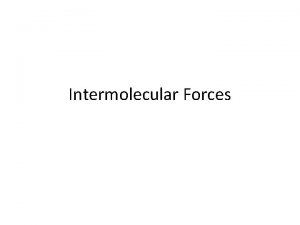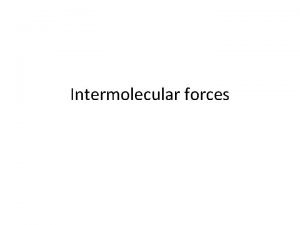Chemistry140 Lecture 33 Chapter 13 Intermolecular Forces Liquids









































- Slides: 41

Chemistry-140 Lecture 33 Chapter 13: Intermolecular Forces: Liquids & Solids v Chapter Highlights ð phases of matter & kinetic molecular theory ð intermolecular forces l metallic & ionic solids l molecular & network solids #Will not include Sections 13. 3, 13. 6 & 13. 7 on physcial properties of liquids and solids

Chemistry-140 Lecture 33 Kinetic Molecular Description of Liquids & Solids v Intermolecular forces are attractive, electrostatic interactions that occur between molecules, atoms, or ions. Liquids: ¶ intermolecular forces are strong enough to hold the molecules together yet weak enough to allow the molecules to move. ¶ generally denser than gases, fairly incompressible, have definite volumes & can flow

Chemistry-140 Lecture 33 Kinetic Molecular Description of Liquids & Solids: ¶ intermolecular forces are strong enough to prevent the molecules from moving. ¶ generally more dense than liquids, incompressible and rigid, do not take the shape of their containers, do not flow. ¶ Crystalline solids: molecules or ions are arranged in repeating patterns possessing high symmetry. ¶ Amorphous solids: molecules are arranged in a random fashion.

Chemistry-140 Lecture 33 Intermolecular Forces v Intermolecular forces: those between molecules, atoms, or ions that hold the particles together. ¶ At a given temperature these forces are solids > liquids > gases ¶ In general, the stronger the intermolecular forces, the higher the melting point and the boiling point

Chemistry-140 Lecture 33 Intermolecular Forces ¶ Ion-dipole forces: electrostatic attractions that form between an ion and an oppositely charged pole of a polar molecule. Ion Dipole d- 40 - 600 k. J/mol d+ Polar water molecule attracted to a cation

Chemistry-140 Lecture 33 Intermolecular Forces ¶ Hydrated cobalt(II) chloride, [Co. Cl 2. 6 H 2 O], is a solid salt. The structure is actually [Co. Cl 2(H 2 O)4]. 2 H 2 O in which 4 of the water molecules are attached to the Co 2+ ion via ion dipole forces. Cl H O Co

Chemistry-140 Lecture 33 Intermolecular Forces ¶ Dipole-dipole forces: between the d+ pole of one polar molecule and the d- pole of another polar molecule. If, equal in mass and size, the attraction increases with increasing polarity. Dipole 5 - 25 k. J/mol including H-bonding

Chemistry-140 Lecture 33 Intermolecular Forces ¶ Dipole-dipole attractions between two molecules of Cl. Br. Cl is more electronegative than Br which creates the permanent dipole (d+ and d-).

Chemistry-140 Lecture 33 Intermolecular Forces ¶ Hydrogen bonding: a special type of dipole-dipole interaction which exists between the hydrogen atom in a polar bond and the unbonded electron pair of an electronegative atom or ion. The strength (4 - 25 k. J/mol) increases in the order N-H…. Y < O-H…. Y < F-H…. Y X-H…. F < X-H…. O < X-H…. N These trends are explained in terms of increasing electronegativities of N < O < F.

Chemistry-140 Lecture 33 Intermolecular Forces ¶ Hydrogen bonding between HF molecules. A lone-pair on F (d-) interacts with an H atom (d+) to give a linear H-bond. This repeats in the solid to form a zig-zag chain of HF molecules

Chemistry-140 Lecture 33 Intermolecular Forces Water is a very unique substance!! High specific heat 4. 18 J/ g K High heat of fusion 333 J/g High heat of vapourization 2250 J/g High dielectric constant 80 @ 20 o. C High surface tension 7. 2 x 109 N/m density of water = 1. 00 g/m. L density of ice = 0. 917 g/m. L. HOW? WHY? . .

Chemistry-140 Lecture 33 Intermolecular Forces O H Hydrogen bond Hydrogen Bonding !!!

Chemistry-140 Lecture 33 Intermolecular Forces Hydrogen bond H O

Chemistry-140 Lecture 33 Intermolecular Forces ¶ Dispersion forces: can exist between formally nonpolar molecules and polar molecules due to the polarizability of the electron clouds on the formally nonpolar molecule. Induced dipoles, d+ and d-, are smaller than permanent dipoles in polar molecules. Dipole Induced Dipole 2 - 10 k. J/mol

Chemistry-140 Lecture 33 Intermolecular Forces ¶ Dispersion forces: can also exist between formally nonpolar molecules due to the polarizability of electron clouds. All liquids and solids possess dispersion forces that tend to increase with increasing formula weight. Induced Dipole 0. 05 - 40 k. J/mol

Chemistry-140 Lecture 33 Intermolecular Forces Question: List the substances Ba. Cl 2, H 2, CO, HF and Ne in order of increasing boiling point.

Chemistry-140 Lecture 33 Intermolecular Forces Answer: Boiling point depends, in part, on attractive forces. Ba. Cl 2: ionic bonding H 2: dispersion forces (M = 2) CO: dipole-dipole forces (M = 28) HF: dipole-dipole forces (hydrogen bonding) (M = 20) Ne: dispersion forces (M = 20) H 2(20 K) < Ne(27 K) < CO(83 K) < HF(293 K) < Ba. Cl 2(1813 K)

Chemistry-140 Lecture 33 Final Exam Monday December 10 th, 2001 12: 00 Noon St. Denis Centre Field House

Chemistry-140 Lecture 34 Chapter 13: Intermolecular Forces: Liquids & Solids v Chapter Highlights l phases of matter & kinetic molecular theory l intermolecular forces ð metallic & ionic solids ð molecular & network solids #Will not include Sections 13. 3 & 13. 6 on physcial properties of liquids and solids

Chemistry-140 Lecture 34 Structures of Solids ¶ Crystalline solid: one in which the molecules, atoms, or ions are ordered in well-defined, repeating, patterns. ionic: Na. Cl molecular: H 2 O metallic: Fe network: C(diamond) Amorphous solid: one in which no order exists; may have small regions of order, but no long-range order. glass: borosilicate glass polymer: nylon

Chemistry-140 Lecture 34 Crystalline Solids Crystalline solids can be described by unit cells. Unit cell: the smallest "piece" of the crystal required to show the repeating pattern.

Chemistry-140 Lecture 34 Crystalline Solids ¶ Unit cells are parallelepipeds (6 -sided figures with faces that are parallelograms) described in terms of the lengths of the edges (a, b and c) and the angles between these edges (a, b, and g) a b c b a g

Chemistry-140 Lecture 34 Crystalline Solids ¶ The simplest unit cell is cubic (a = b = g = 90 o) and (a = b = c). The primitive cubic unit cell consists only of atoms at the corners of the box. a b c a b g

Chemistry-140 Lecture 34 Cubic Unit Cells Primitive Cubic Body Centred Cubic Face Centred Cubic

Chemistry-140 Lecture 34 Atom Sharing Between Unit Cells ¶ In any cubic lattice, a corner atom is shared equally between eight unit cells. ¶ It therefore only contributes 1/8 of an atom to that particular unit cell

Chemistry-140 Lecture 34 Atom Sharing Between Unit Cells ¶ In any cubic lattice, a face-centred atom is shared equally between two unit cells. ¶ It therefore only contributes 1/2 of an atom to that particular unit cell

Chemistry-140 Lecture 34 Atom Sharing Between Unit Cells ¶ The body-centred cubic unit cell has an atom at the centre of the box in addition to the eight atoms in the corners. A body-centred atom is not shared and therefore contributes one full atom to the unit cell. ¶ Atoms may also be found on the edges of the box. An edge -centred atom is shared equally between four unit cells. It therefore only contributes 1/4 of an atom to that particular unit cell.

Chemistry-140 Lecture 34 Crystal Lattice Measurements Example 13. 6: Aluminium has a density of 2. 699 g/cm 3 and the atoms are packed into a face-centred cubic unit cell. Determine the radius of an Al atom.

Chemistry-140 Lecture 34 Crystal Lattice Measurements Known: the density of Al the structural make-up of the basic unit cell We know that: Mass of the unit cell = (# of Al atoms)(atomic weight of Al) Volume of a cube = (length of the side)3

Chemistry-140 Lecture 34 Crystal Lattice Measurements If we know the length of the side then we can determine the radius of a single atom!! Cell diagonal Cell edge

Chemistry-140 Lecture 34 Crystal Lattice Measurements Step 1: We know M, N and d but need to calculate Z. Each atom at the centre of a face contributes 1/2 of an Al atom to the cell. 6 x (1/2) = 3 Al atoms Each atom at the corner contributes 1/8 of an Al atom to the cell. 8 x (1/8) = 1 Al atom Z = 3 + 1 = 4 Al atoms

Chemistry-140 Lecture 34 Crystal Lattice Measurements Step 2: Use the equation: Solve for V using: = 6. 640 x 10 -23 cm 3

Chemistry-140 Lecture 34 Crystal Lattice Measurements Step 3: Use the equation: = 4. 049 x 10 -8 cm

Chemistry-140 Lecture 34 Crystal Lattice Measurements Step 4: and the equation: = 1. 432 x 10 -8 cm = 1. 432 Å

Chemistry-140 Lecture 34 Ionic Solids Cl- Cs+ Cs. Cl Lattice

Chemistry-140 Lecture 34 Ionic Solids Expanded Na. Cl Lattice

Chemistry-140 Lecture 34 Ionic Solids The Cl- anions form a face-centred unit cell and the Na+ cations fill the spaces, such as the centre of the unit cell. There must of course be equal numbers of cations & anions!! (Z = 4) Cl. Na+

Chemistry-140 Lecture 34 Molecular & Network Solids ¶ Molecular solids: those in which the particles that comprise the crystal are molecules.

Chemistry-140 Lecture 34 Molecular & Network Solids ¶ Covalent network solids: those in which the crystal itself is a large, covalently bonded, molecule.

Chemistry-140 Lecture 34 Textbook Questions From Chapter # 13 Intermolecular Forces: 20, 22, 26 Metallic & Ionic Solids: 43, 45, 48 Molecular & Network Solids: 52 General Questions: 60, 69 Conceptual Questions: 88

Chemistry-140 Lecture 33 Final Exam Friday December 10 th, 2001 12: 00 Noon St. Denis Centre Field House
 Intramolecular forces vs intermolecular
Intramolecular forces vs intermolecular Intermolecular forces ranked
Intermolecular forces ranked Inter vs intramolecular forces
Inter vs intramolecular forces London dispersion forces induced dipole
London dispersion forces induced dipole Intermolecular forces webquest answers
Intermolecular forces webquest answers Intermolecular forces
Intermolecular forces 3 types of intermolecular forces
3 types of intermolecular forces Imf chem
Imf chem Factors affecting solvation
Factors affecting solvation Dipole dipole interaction example
Dipole dipole interaction example Phthatic
Phthatic Intermolecular forces
Intermolecular forces Intermolecular forces symbol
Intermolecular forces symbol Dipole dipole interaction example
Dipole dipole interaction example Boiling point with intermolecular forces
Boiling point with intermolecular forces 3 types of intermolecular forces
3 types of intermolecular forces Intermolecular forces present in hbr
Intermolecular forces present in hbr Strongest to weakest intermolecular forces
Strongest to weakest intermolecular forces Gecko feet facts
Gecko feet facts Induced dipole induced dipole interaction
Induced dipole induced dipole interaction Intermolecular forces from strongest to weakest
Intermolecular forces from strongest to weakest Similarities of intermolecular and intramolecular forces
Similarities of intermolecular and intramolecular forces Ch2cl intermolecular forces
Ch2cl intermolecular forces Intermolecular forces lesson
Intermolecular forces lesson Mind map about friction
Mind map about friction Ch2cl intermolecular forces
Ch2cl intermolecular forces Coh2 intermolecular forces
Coh2 intermolecular forces Viscosity and intermolecular forces
Viscosity and intermolecular forces Intermolecular forces capillary action
Intermolecular forces capillary action Is matter
Is matter Why intermolecular forces are weaker than intramolecular
Why intermolecular forces are weaker than intramolecular Nof intermolecular forces
Nof intermolecular forces Intermolecular forces ap chemistry
Intermolecular forces ap chemistry Intramolecular forces list
Intramolecular forces list Reading forces you to be quiet
Reading forces you to be quiet Intermolecular forces in sugar
Intermolecular forces in sugar Interatomic and intermolecular forces
Interatomic and intermolecular forces Type of intermolecular forces
Type of intermolecular forces Unit 3 intermolecular forces and properties
Unit 3 intermolecular forces and properties No structure
No structure Sucrose intermolecular forces
Sucrose intermolecular forces Hco2h intermolecular forces
Hco2h intermolecular forces



